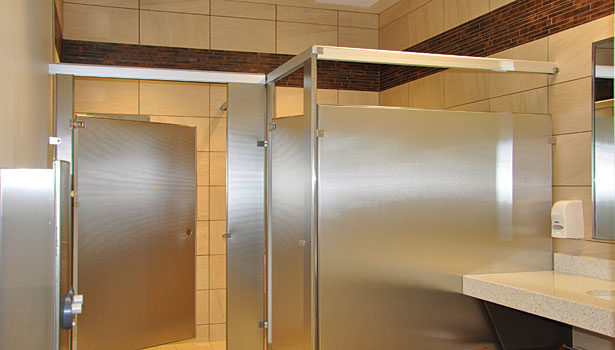In 1966 and 1985, large-scale additions were made to the Hall and most of the interior hallmark features were insensitively handled, causing much of the building to lose its original appeal. In 2012, the College of Arts and Sciences chose the vacated building to house its Administrative offices and History department, which is when the University decided to enlist the help of the Milwaukee, WI-based architectural firm Korb Tredo Architects to complete a building-wide renovation.
“In preparation [of moving the Administrative offices and History department to Sensenbrenner Hall], Marquette University brought the following challenges to the design team: return Sensenbrenner Hall back to its original charm and prominence, introduce contemporary building and technology systems, and create a modest addition that offers a highly transparent face to the adjacent community,” said Angela Ryun, interior designer at Korb Tredo Architects, part of the architectural design team. “While these goals were conflicting, the team addressed each one in the final design.”
First, to restore Sensenbrenner Hall back to its original condition, the additions were removed and the original architectural features were re-introduced. “The library skylight and mezzanine were rebuilt to create enclosed faculty offices beneath and an open graduate student workspace above,” said Ryun. “The Reading Room fireplace and stained glass windows were restored. [And] the terrazzo floors and curved wood handrails were refinished in the stairwells.
“Second, the Reading Room lacked adequate mechanical, fire suppression and technology systems,” Ryun went on to say. “Each of these systems was integrated into the room with minimal impact by meticulously weaving the systems between existing layers of construction.”
The last leg of the Sensenbrenner Hall renovation was an 8,000-square-foot, four-story addition, which was placed on the south side and was largely composed of curtain wall glazing to give the college a presence in the adjacent community, according to Ryun. “Vertical circulation and new building systems were housed in this building section to keep the original structure as close to its intended form as possible,” she said. “Most importantly, the addition offers the college a naturally lit gathering space that they had been lacking for years.”
|
Marquette University Milwaukee, WI Architect: Korb Tredo Architects, Milwaukee, WI Tile Manufacturer: Ragno USA, Sunnyvale, TX; Eleganza Tiles, Inc., Edison, NJ; Crossville, Inc., Crossville, TN Installer/Tile Supplier: Hetzel Tile & Marble, Inc., Milwaukee, WI |
According to Ryun, the University was actively involved with the design process, contributing to the overall design goals and meeting with the architectural design team at least once or twice each week to discuss everything from programming to construction phasing.
To complete all of the renovations made to Sensenbrenner Hall — which now spans 32,700 square feet with its new addition — a combination of porcelain tile from Ragno USA, Eleganza Tiles, Inc. and Crossville, Inc. was employed throughout the various restrooms and corridors in the building — all supplied by Hetzel Tile & Marble, Inc. in Milwaukee, WI. The restrooms feature Ragno’s Lifestyle color-body porcelain tile collection in “BG,” a very light beige, in 12- x 24- and 24- x 24-inch formats; and Eleganza Tile’s Metallica porcelain tile collection, which incorporates thin, horizontal rectangular mosaic tiles, in the color brown. The corridors also feature Ragno’s “Lifestyle” collection in “BG” in 12- x 24- and 24- x 24-inch formats, as well as Crossville, Inc.’s Now porcelain stone tile collection in “Rust” in a 6- x 24-inch format.
When choosing the types of tile to use for the project, Ryun said she and the design team took multiple other options into consideration before making a final decision — in regard to manufacturer, style, size, color, environmental impact and cost — but ultimately chose the collections because of the way they flowed with the existing floor materials in the building.
“Korb Tredo Architects’ original project effort was to be with the renovation and new addition of Sensenbrenner Hall only. The building includes original terrazzo floors and a portion of the design intent was to retain as much of the terrazzo floors as possible,” said Ryun. “Due to various programming efforts and pre-determined departments being relocated to Sensenbrenner Hall upon building completion, we knew early on that there would be some locations where existing terrazzo and new flooring would meet, such as in the addition we were designing. As a result, we needed to find a solution that worked for all conditions.
“Additionally, upon the project being awarded to us, we were told that we would also be renovating Marquette Hall, which included many of the same building conditions (also built in 1923), included original terrazzo floors in similar palette,” Ryun went on to explain. “As our design team, along with Marquette University, was preparing to present to user groups amongst both projects, there was a desire to unify the palettes, yet create individual identities between the two buildings. As a result, we determined that we would select the same flooring product, [Ragno’s Lifestyle collection], but vary the size between the two building locations.”
With the subsequent renovation of Marquette Hall, Ryun and the team used the same collections as they did for Sensenbrenner Hall, with the exception of Crossville’s Now collection. In the restrooms, Ragno’s Lifestyle collection in “BG” is featured in both 12- x 24- and 24- x 24-inch formats, as well as Eleganza Tile’s “Metallica” collection in the color Brown. As in the restrooms, the corridors incorporate Ragno’s Lifestyle collection in “BG,” but only in a 12- x 24-inch format.
When completing the two renovations, Ryun and the design team encountered one small challenge in regard to the size of tile they wanted to use. “Our original design intent was to install large format (24 x 48 inches in Sensenbrenner Hall) due to our expansive corridors and design intent for a monolithic clean aesthetic with minimal grout lines,” said Ryun. “Due to cost estimations, it was determined that there would be a savings for moving forward with a smaller-format tile (12 x 24 and 24 x 24 inches) and as a result, the smaller-size tile was utilized over the larger 24- x 48-inch tile.”
Although the Sensenbrenner Hall renovation was completed in May of 2014, about one year after programming began in mid-2013, the Marquette Hall renovation is still ongoing, with a completion date set for later this year. “Marquette Hall also started programming in mid-2013 with a majority of construction completed this past August 2014 for the start of fall semester,” said Ryun. “The remaining fourth floor will be renovated from December [2014] through spring/summer 2015.”
Since the Korb Tredo Architects’ office is in such close proximity to Marquette University, Ryun said she and the team were onsite multiple times each week to supervise the renovations. “Due to the historic nature of our project, occasionally elements appear that were not previously expected, based on past historic documentation. Being present on site assists resolution in a timely manner of items such as this,” said Ryun. “Additionally, we were watching for consistency of installation with our design documentation.”
Since the renovation’s completion, Ryun said the college has noted “a measurable change in their culture,” among many other things. “They have shared that the design facilitates more impromptu conversations, project collaborations and gatherings than they have enjoyed in years past,” she said. “Additionally, in the coming month, our team looks forward to attaining more user feedback and LEED Silver status for this campus gem that has now reclaimed its importance on the Marquette University campus.”





